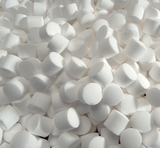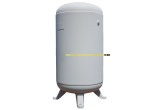Sizing an Air Receiver Tank for Compressed Air
Installing an air receiver tank can be a game-changer for many air compressor setups. It's like having a reservoir of air on standby, ready to tackle those demanding jobs.
Now, these tanks come in all shapes and sizes - from petite 5-gallon ones to the behemoths holding thousands of gallons. The trick is to find that Goldilocks zone where the tank size meets your compressor's and application's needs.
Portable Air Compressors: A Closer Look
Reciprocating Air Compressors:
These compressors love having an air receiver tank by their side. It’s their way of ensuring a smooth ride by stashing away some extra air. Once the tank is filled up, you’re good to go. But as you use the tool, the tank's air level dips, and you'd need to hit pause till it tops up again. So, choosing the right tank size can be a real time-saver.
Here’s a simple rule of thumb: take the tool with the highest CFM at the required PSI, multiply that by either 1.25 or 1.5, and round it up to the nearest gallon. It's as easy as pie!
Rotary Screw Air Compressors:
These guys are the independent sort. Many times, they don't even need an air tank, thanks to their continuous air supply. But, if you’re working with higher CFM tools, an air receiver tank can be an ideal accessory. For instance, if your 1” impact wrench needs 40 CFM but your compressor provides 30 CFM, a 12-gallon air receiver tank can bridge that gap nicely. It’s a savvy way to stretch the system a bit further without breaking the bank.
Stationary Air Compressors: A Bit of a Brain Teaser
Sizing air receiver tanks for stationary applications is a tad more complex and calls for some engineering prowess. It’s a balancing act between several factors like air demand, compressor size, pipe size, and control system strategy.
There’s a well-known formula to solve this puzzle:
And here’s a breakdown:
- V is the volume of the tank in cubic feet
- t is the time it takes for the pressure to drop from the max to min
- C is the free air needed in SCFM
- pa is the atmospheric pressure (usually 14.7 PSIA)
- p1 and p2 are the max and min tank pressures in PSIA.
Let’s take an example: Say your system has a mean air consumption of 20 CFM, max tank pressure of 175 PSI, min tank pressure of 90 PSI, and the tool runs for a minute. Plug these values into the formula and voila, you get the ideal tank volume.
But remember, this formula is best suited for large reciprocating air compressor systems with fluctuating airflows. Stationary rotary screw air compressor systems, running at full throttle, may not need an air receiver tank if sized correctly for the job.
Regardless of your application, Compressor Shop can help review your requirements and recommend the appropriate sized air receiver tank for your compressed air system. Nearly 50 years of treating compressed air.
Recent Posts
-
The Resurgence of Natural Gas Deliquescent Dryers and Desiccants in 2025
How emission-free deliquescent desiccant technology is paving the way for greener operations and low …Jan 06, 2025 -
The Origins and Evolution of Compressed Air Technology
Compressed air, often referred to as the "fourth utility" alongside water, electricity, and natural …Jun 28, 2024 -
Popular Sizes of Vertical Air Receiver Tanks
Sizing and deciding on the best air receiver tank for your compressed air application can be conf …May 05, 2024




